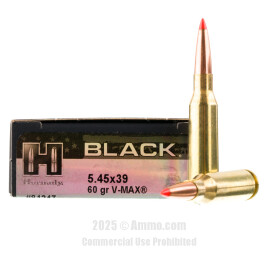Best 5.45x39 Ammo: Ultimate AK-74 Ammunition Guide
The Soviet 5.45x39 has been the Pepsi to the 5.56x45 NATO’s Coke since the height of the Cold War, but because of import restrictions, it can be a real bear (Soviet pun intended) to find good ammo for a 5.45 rifle if you’re not in a former USSR country or at least near one.
We’re going take a deep dive into the best 5.45x39 ammo out there (which is Hornady Black 60gr V-MAX 5.45x39), how to choose the best option to meet your particular needs, and some tips for storing your ammo and some other important background info to help you get the most out of it.
This should be enough to point anyone looking for 5.45x39 ammo, whether for target shooting, varmint hunting, or even self-defense, in the right direction the next time they go shopping for something to feed their AK mags.
Summary of the Best 5.45 Ammo

Our Top 5.45x39 Ammo Recommendations
Below you’ll find a more detailed breakdown of the ammo we’ve chosen, as well as detailed reviews and recommendations for specific uses.
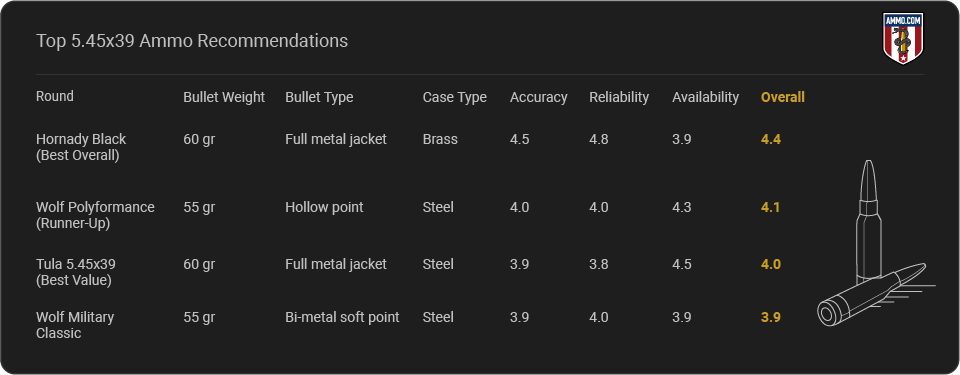
Hornady Black 60 Grain V-MAX 5.45x39 (Best Overall)
Specs
- Muzzle Energy: 1052 ft-lbs
- Muzzle Velocity: 2810 fps
- Bullet Weight: 60gr
- Bullet Type: Hornady V-MAX
- Best Uses: Serious target shooting, personal defense, varmint hunting
Pros
- Most accurate
- Most reliable
- Brass-cased
- American-made
Cons
- Expensive
- Hard to find in stock
First up, we have the only brass-cased option on the list: Hornady’s Black series 60gr V-MAX load. This is by far the most accurate and consistent 5.45 ammo wee tested, and it performs well in a variety of situations.
It comes topped with Hornady’s excellent V-MAX bullet and features modern powder and non-corrosive primers (unlike a lot of surplus stuff out there). It ignites fairly cleanly. The brass cases have a low coefficient of friction and can be reloaded, which gives this ammo a huge leg up on the competition.
The only downsides to this ammo are really due to the market for 5.45 ammo itself. Unfortunately, there’s not a lot available and not a lot of interest in it in the United States which makes what few American-made 5.45 options there are out there a little expensive.
Beyond that, this is a great round and easily the highest-performing option you’re likely to have access to without joining the Russian military (which we typically advise Americans against doing).
Wolf Performance Polyformance 55 Grain Hollow Point (Steel-Cased) (Runner-Up)
Specs
- Muzzle Energy: 957 ft-lbs
- Muzzle Velocity: 2936 fps
- Bullet Weight: 55gr
- Bullet Type: Bimetal-Jacketed Hollow Point
- Best Uses: Varmint hunting, target shooting
Pros
- Affordable
- Hollow point
- Polyformance coating
- High velocity
Cons
- Steel-cased
- Not as consistent as Hornady Black
Next up, we have Wolf Polyformance, a more general-purpose round that can be used for everything from casual plinking to varmint hunting without breaking the bank. This affordable steel-cased ammo is a great option if you want to shoot a lot on a budget.
This round's case's "Polyformance" (i.e. polymer) coating means it feeds and extracts well. We've never seen it rust, even when stored in factory cardboard boxes.
For general target shooting, training, or just turning money into noise at the range, this is a really good option.
That said, the fact that this is an expanding projectile makes this a good option for self-defense or even varmint hunting/pest control if you’re using a 5.45 gun for that kind of thing. This also makes it the most versatile option on this list and a great general-purpose round to stock up on.
Tula 5.45x39 60 Grain FMJ (Steel-Cased) (Best Value)
Specs
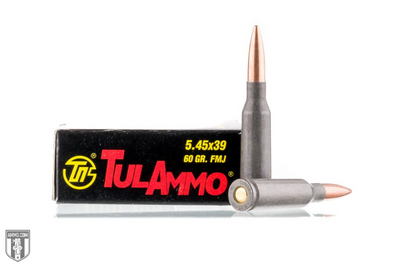
- Muzzle Energy: 922 ft-lbs
- Muzzle Velocity: 2701 fps
- Bullet Weight: 60gr
- Bullet Type: Bimetal-Jacketed Full Metal Jacket
- Best Uses: Training, plinking, general target shooting
Pros
- Very affordable
- Phosphate polymer coating
- Non-corrosive Berdan primer
Cons
- Steel-cased
- Not very consistent
- Doesn’t feed well in anything but an AK-74-pattern firearm
Oh, Tula, where would preppers and broke college students (and gun writers) be without you? Their 5.45x39 ammo is exactly what you’d expect if you’re familiar with the brand.
If you’re unfamiliar, to summarize, it goes bang reliably, and the bullet goes about where you tell it to. It even feeds pretty well as long as you don’t run it in a finicky, high-tolerance 5.45 gun.
Most 5.45 guns are AK-74 variants with appropriately loose machining tolerances by design, so you probably won’t have a problem feeding your gun the cheap stuff, depending on your intended use case.
This is the epitome of “buy it cheap and stack it deep” ammo, so if you’re prepping for the apocalypse (or as we call it now, “Another Thursday”), then this is a great option. It's also one of the easiest options to find in 500-1000 round box containers, which is a great way to save a bit of money.
Wolf Military Classic 60 Grain FMJ (Steel-Cased)
Specs
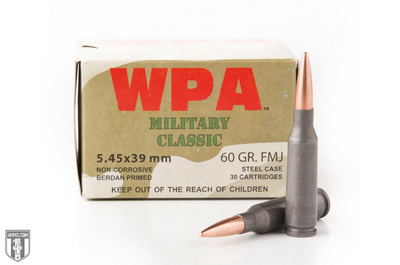
- Muzzle Energy: 1061 ft-lbs
- Muzzle Velocity: 2822 fps
- Bullet Weight: 60gr
- Bullet Type: Bimetal-Jacketed FMJ
- Best Uses: Serious target shooting, personal defense, varmint hunting
Pros
- Cheap
- Available in bulk
- Similar performance to early 5.45 ammo
- Good velocity for 60gr bullet
Cons
- Hard to find in stock
- Steel-cased
- Coating isn’t great
Lastly, we have Wolf Military Classic 60gr: another great target shooting and plinking option, though it is a little more expensive than the Tula option above.
In our experience and testing, it’s a bit more accurate and tends to feed a little better, but it’s also a touch more expensive (though it's difficult to say whether the extra $.10/round is worth the extra performance you get).
As with all things, test it and see what you think. None of the ammo on this list is prohibitively expensive, and grabbing a few boxes of each to test with your specific gun isn’t a bad idea.
That said, Wolf Military Classic is a great general-use ammo that’s available in cases of 750 rounds, making it a good one to go all in on and stock up on.
Other 5.45 Ammo
There are a ton of other 5.45 ammo options out there…they just aren’t regularly available in the U.S., particularly from major retailers. In general, some of these rounds can be good, such as Red Army Standard and Barnaul, but do your own research and remember that your mileage may vary.
Make sure you know if the primers are corrosive or not and how to deal with that if they are, and make sure you’re buying stuff that’s been stored properly. Rusty steel cases are not fun to extract.
Understanding 5.45x39 Ammo
The 5.45x39 is a Russian-made cartridge that came out of the Cold War conflicts of the 1970s. Since then, it has been a favorite in countries occupied by the now-defunct Soviet Union and is still used by the Russian military.
Like the American 5.56x45, the 5.45x39 is an intermediate cartridge, meaning it exists as a sort of middle-ground option between pistol calibers and heavier rifle calibers like the various 7.62 flavors.
It was intended to be a lightweight infantry cartridge that a Red Army soldier could easily schlep around a few hundred of in a chest rig or backpack and fire on full-auto without hitting mostly the sky.
It has fairly decent penetration in soft tissue and tends to tumble and yaw its way through flesh in unusual paths, which lead Afghan Mujahideen to label it the “poison bullet”, which we’ll go over a little more in a bit.
The main rifle that fires this little bundle of joy is the AK-74 and its myriad variants (AKS-74. AKS-74U, AK-74UN, AK-74M, etc, etc). Beyond that, there are a few options like certain Galil and AR-15 variants, the AK-104, and Russian VEPRs, but really not a lot here in the U.S.
Of course, even the best gun is basically just a fancy stick without good ammo, and a gun with unreliable ammo is barely better (or maybe worse), so it’s always vital to load up on stuff that you can trust.
Unfortunately, that’s not always as easy as it sounds. Let’s take a look at some of the issues you’ll run into with choosing 5.45 ammo in particular and how to avoid these pitfalls.
Common Challenges for Choosing the Best 5.45x39 Ammo
This original loading, the 7N6 cartridge, has been banned from U.S. import due to regulations against anti-armor-piercing ammo, and further rounds have been made unavailable due to import sanctions levied against the Russian government due to the annexation of Crimea and the war in Ukraine in general.
This makes choosing (or even finding, for that matter) good 5.45 ammo a real hassle for U.S.-based shooters because very little is being imported. There’s also relatively limited demand for domestic producers to fill the hole in the market.
Here in the U.S., we tend to gravitate towards our AR-15 cartridges, and 5.45x39 ARs are rarer than the proverbial hen’s teeth, so only one or two major manufacturers here in the U.S. make the stuff, and even then, it’s in limited quality.
Buying the Best 5.45x39 For Your Specific Circumstances
When it comes time to choose which ammo you’re buying, you should generally tailor your purchases to what kind of shooting you’re doing and what your situation is.
For example, if you’re a reloader or competition shooter, or you just have really high standards for your 5.45x39 gun’s performance, go with the Hornady Black brass-cased stuff.
Or if you’re reading this in the far-flung future from when it was written, try to find another option with a brass case. I dream of a future where such a thing is possible, and multiple manufacturers churn out 5.45x39 ammo wearing shiny brass clothes instead of steel.
Why? Brass is slicker, so it feeds and ejects better. The alloy's elasticity also permits it to be reloaded. That makes every brass-cased 5.45x39 round even more valuable because it can be reused.
It's almost always easier to find bullets to reload 5.45x39 ammo than it is to find loaded cartridges ready to be fired, so this brass-cased ammo is a huge advantage.
But what if you’re not looking for high-performance shooting and you just want to rip a bunch of ammo at the range? Then the standards we have for our ammo can relax a little bit, and steel-cased ammo starts to make more sense because it's cheaper and available in bulk.
Steel-cased ammo can’t be reloaded, and it doesn’t feed or extract as reliably, but it is significantly cheaper than brass, which makes it great for cheap ammo that you don’t expect a lot of performance out of.
You’ll also want to pay attention to the coating on your steel-cased ammo. In general, stay away from lacquer-coated stuff and stick to polymer coatings.
These coatings help with feeding and extraction and prevent corrosion, but the lacquer coatings can cause issues in some guns and generally don’t perform as well during the firing cycle or at preventing corrosion.
In terms of actual ballistic performance, we’re greatly limited by the varieties of 5.45 ammo out there and the quality of what’s available.
Some steel-cased stuff is very accurate and reliable, so you may not have any problems with it, especially in something with loose machining tolerances like the average AK, but it’s probably not going to win you any marksmanship competitions.
That said, things like accuracy and reliability are important with all ammo, including 5.45 surplus ammo, and you should keep these things in mind.
Maintenance and Storage of 5.45x39 Rifle Ammo
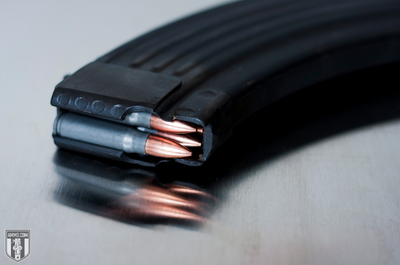
So now you’ve got all this 5.45x39 ammo; what do you do with it?
With the brass-cased ammo, it’s easy to simply leave it in the factory packaging if you shoot often because you basically aren’t ever going to find 5.45x39 brass ammo in bulk, and the small 20-round packs won’t sit idle for long.
Steel-cased ammo is a bit of an issue, though, especially if you’ve got something like older bulk ammo in one of those tin cans. Yes, those cans can last a really long time, but if they’re damaged or dented in any way, they can let moisture in, and that’s going to cause a level of rust that will ruin the ammo.
Be sure to check your spam cans carefully for dents and holes, and make sure the seal is intact.
If you are buying steel-cased ammo, lacquer and polymer coatings are available. The latter is typically preferred. Lacquer-coated cases aren’t recommended by some manufacturers, and can increase the fouling rate of your rifle. Anecdotally, the 5.45x39 lacquer-coated stuff also seems to rust faster.
Lastly, if you’re repacking ammo or storing it for a long time, it's always a good idea to invest in airtight containers and desiccant packets.
You can get textile/fabric ones in bulk, save ones that come with shoes, clothes, and electronics you buy, or get reusable desiccant packs that can be refreshed in the oven once they become saturated with moisture.
On the container side of things, you can go with purpose-built ammo containers and leave it at that, or you can go a step further and vacuum pack your ammo in smaller bundles and then store them in the can from there.
With vacuum sealers available for around $25-$30 these days, storing rounds in small vacuum-sealed packs and opening them as needed is a great option as it greatly limits the ammo's exposure to air and, therefore, moisture.
Dehumidifiers don’t hurt either, but are generally more for something like a reloading room or large safe room as they'll require you to empty the collected water often, which can be a hassle.
The History and Development of 5.45x39 Ammo
In the early 1970s, a group of Soviet military designers and engineers were hard at work developing an intermediate rifle cartridge to compete with the successful 5.56x45 ammo developed by Remington those pesky Amerikanskis across the Atlantic were using.
This was part of a large push from many militaries around the world to adopt service cartridges that were less powerful and lighter than the 7 to 8mm ones that were primarily in use with major militaries at the time.
In 1974, the result of all of Ivan’s hard work was inducted into service. The 5.45x39mm was born.
The original round uses a rimless, bottlenecked steel case with a 39.82mm overall length, a 6.29mm case neck, and a 53gr bullet. Modern versions sometimes ditch the steal case and mostly use a 60gr bullet, but other than that, not much has changed.
Since it was adopted fully, it has survived the fall of the Iron Curtain and the Soviet Union’s breakup and has continued as the primary service cartridge of Russian armed forces to this day.
Furthermore, the future assault rifles of the Russian military, as far as we humble American gun writers can tell from here, are also going to be chambered in 5.45x39.
Innovations and Advances in 5.45x39 Ammo Technology
The Russian military has breathed new life into the aging 5.45x39 and, as far as we can tell from our side of the Atlantic, seems to be leaning into high-performance armor-piercing ammo for the 5.45 rather than a higher-energy cartridge.
Russia has historically skewed towards heavy armor, and heavier armor-piercing projectiles in its warfighting doctrines, and these new projectiles seem to be in line with that. Supposedly, according to the designer, the new 7N39 ammo is significantly better at defeating armor than older variations.
According to him, the new rounds penetrate standard Russian body armor at distances beyond 70 meters and provide a greater “density of fire” over the previous service rounds. What exactly does any of that mean? It's difficult to say, and the Kremlin isn’t returning our requests for comment.
What it does tell us is that the Russians seem committed to the 5.45 round, at least for the immediate future, which means this round is likely to be with us for a good long time.
Available Firearms Chambered in 5.45x39
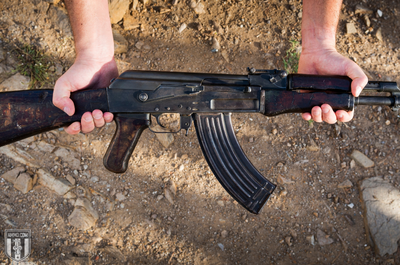
When it comes to expanding your 5.45x39 firearm collection, options are more limited.
There are a variety of AK-74 variants out there that are sometimes imported for the civilian market, but with current restrictions on imports and sanctions on Russia, these imports have more or less dried up.
The same goes for the 5.45 VEPR semi-auto rifles made in Russia, the various bolt-action options, and who knows how many other rifles that we’ll just never see now. Some of them are here already, though, and come up for sale from time to time.
American makers and importers like Riley Defense and Lee Armory offer semi-auto 5.45 AKs. Still, these have doubled in price since the recent sanctions took effect, so good luck finding one and/or stomaching the purchase price.
Your best bet a lot of the time is going to be to check physical brick-and-mortar stores and the local used market for 5.45 firearms, as opposed to online retailers.
Frequently Asked Questions About 5.45x39 Ammunition
What is the best 5.45 ammo?
The best 5.45 ammo is Hornady Black Series 60 grain V-MAX. It is the highest-quality ammo commercially available.
Why is the 5.45 x39 called "the poison bullet?"
Accounts vary, but the prevailing theory is that Afghani Mujahideen were so impressed by the round’s performance that they gave it the nickname as a term of respect and fear.
What 5.45 round does the Russian military use?
The current high-end Russian military rounds are the armor-piercing 7N39 and 7N40 rounds.
What is the effective range of a 5.45x39?
The effective range of 5.45x39 tops out at around 600 meters. Beyond that, accuracy degrades too much to be very reliable, as does terminal performance against soft tissue.
What is the bullet diameter of 5.45x39?
The bullet diameter of the 5.45x39 cartridge is 5.60mm or .220”.
What are the disadvantages of using 5.45x39?
It's relatively hard to find, and also greatly limits your options when it comes to rifle selection.
What is the best round for a 5.45x39 firearm?
The best round for a 5.45x39 firearm is the Hornady Black 5.45x39 60gr V-MAX load. If you’re a Russian servicemember (or Escape from Tarkov player), 7N39 or 7N40 are the ones to go with.
Is the 5.45 x39 a good choice for hunting?
The 5.45x39 is not a good choice for hunting. The ammo and rifles available aren’t very suited to hunting, and the round itself isn’t particularly good for hunting either.
You could easily use it for varmint hunting/pest control, however.
Why is the 5.45x39 so popular?
The 5.45c39 is popular because it is the service cartridge for the Russian military. Beyond that, the popularity of the AK-74 and its many, many, many variants and derivatives means that this round is likely to remain popular for years to come.
Parting Shots: Wrapping up 5.45x39 Ammo
Buying 5.45x39 ammo can be a bit of a headache, but hopefully, you’re now on firmer ground when it comes to sourcing your own and getting your hands on stuff that works for your intended use case.
Be sure to check out what 5.45x39 ammo is in stock at Ammo.com!
Cartridge Recommendations
- Best Caliber for Deer Hunting
- Best Big Game Caliber
- The 10 Best Coyote Cartridges
- Best Cartridge for Elk Hunting
- Best Cartridge for Self-Defense
- Best Cartridge for Concealed Carry
- Best Handgun Cartridge
- Best Moose Cartridges
- Best 40 S&W Ammo For Self Defense & Target Practice
- Best 223 Ammo
- Best .44 Magnum Ammo
- Best 270 Ammo for Hunting
- Best 17 HMR Ammo for Varmint Hunting and Plinking
- Best 22 Rimfire Ammo
- 4 Best AK-47 Ammo Picks [7.62x39]
- Best 38 Special Ammo for Self Defense
- Best Handgun Ammo for Self-Defense in Common Calibers
- Best 308 Ammo For Hunting & Target Shooting
- Best 300 Win Mag Ammo
- Best 243 Ammo for Target Shooting
- 10 Best 6.5 mm Cartridges For Long-Range Shooting and Hunting
- Best 45 ACP Hollow Points for Self-Defense
- Best 12 Gauge Ammo for Home Defense
- Best 32 ACP Ammo for Your Pocket Pistol or Backup Gun
- Top 13 Best AR Calibers That Aren’t 5.56 NATO
- Best Ammo for Smith and Wesson M&P 9mm Shield
- Best 7.62x39 Ammo for Self Defense
- Best 20 Gauge Ammo for Home Defense, Whitetail, and Upland Game
- Best Ammo for 1911 45 ACP
- Best 12 Gauge Ammo for Deer Hunting
- Best .40 S&W Ammo for Self Defense
- Best 7.62x39 Hunting Ammo
- Best 5.56 Ammo for Home Defense
- Best 380 Self-Defense Ammo
- Best 45 ACP Ammo for Every Situation
- Best Ammo for Glock 43x
- Top 5 Best 22 WMR Ammo on the Market
- Best Ammo for Glock 19
- Best Sniper Ammo
- Best 38 Special Ammo For Target Practice Precision Shooting
- Top 5 Best 45 ACP Ammo for Target Practice
- Best 6.5 Creedmoor Hunting Ammo
- Top 10 Best Sniper Rifle Cartridges
- Best 6.5 Grendel Ammo
- Best 5.45x39 Ammo for Your Gun
- Best 10mm Ammo for Bear Defense
- Best 350 Legend Ammo
- Top 5 Best 30-06 Ammo for Deer Hunting
- Best 30-06 Ammo for Accuracy
- Best 300 Win Mag Ammo for Deer
- Best M193 Ammo for Stockpiling
- Best 300 Blackout Ammo for a 7.5" Barrel
- Best Shotgun Shells for Target Practice
- Best 45 ACP for Bear Defense
- Best 223 for Deer Hunting
- Best Exotic 9mm Ammo
- Best Duck Hunting Shells
- Best .357 SIG Defensive Ammo
- Best Beretta APX 9mm Ammo
- Best 22 Pistol Ammo
- Best 9mm Ammo
- Best 308 Ammo for Deer Hunting
- Best Ammo for the Taurus GX4
- Best Ammo For Taurus PT111 G2
- Best Shells For Trap Shooting
- Best 38 Special Ammo for Snubbies
- Best 410 Ammo For A Taurus Judge
- Best Ammo for Ruger Security 9
- Best Ammo for Taurus G3c
- Best 7mm Rem Mag Ammo
- Best Lead-Free Hunting Ammunition
- Best 300 Blackout Ammo for Hog Hunting
- Best 9mm Home Defense Ammo
- Best 10mm Ammo for Every Shooting Situation
- Best .22 LR Ammo for Self-Defense
- Best Long-Range Hunting Bullets
- Best 357 Magnum Ammo For Every Shooting Situation
- Best 45 ACP Ammo For Self-Defense
- Best 6.5 Creedmoor Ammo For Accuracy
- Best 45-70 Ammo For Hunting & Target Shooting
- Best Turkey Loads
- Deadliest Shotgun Ammo For Home Defense
- Best 300 Win Mag Ammo For Elk Hunting
- Best 9mm Subsonic Ammo
- Best 7mm PRC Ammo
- Best 300 Blackout Subsonic Ammo
- Best 308 Subsonic Ammo for Hunting
